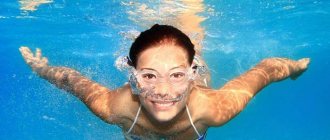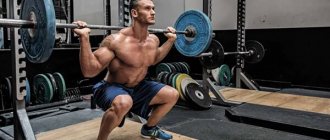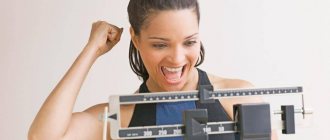I must admit that both the swimming pool and the gym take a lot of energy if you train conscientiously and not recklessly.
There is a main contradiction between the pool and the gym, which prevents you from doing both swimming and bodybuilding. This contradiction is inherent in the movement technique of swimming and lifting weights.
Create a strength training program for free
What are the benefits of swimming and running?
What muscles are stressed when playing these sports?
Running is popular all over the world - a well-known fact. It is practiced by people of all ages. The benefits of running have been studied and proven by scientists and doctors. Jogging is great for strengthening your heart. It becomes more resilient, oxygen supply to organs and blood flow improves. Joints are strengthened, the nervous system is stabilized, and immunity is increased. The body maintains vitality. Shortness of breath disappears. Metabolism improves, calories are burned well, and the body loses weight.
A person who runs regularly gets rid of stress and is charged with a positive attitude. Running forces all muscle groups to work. The muscles of the thighs, buttocks, adductors, flexors and extensors of the knee receive greater load. When jogging, the quadriceps and intercostal muscles actively work, tensing during exhalation and inhalation. The calves, which act as stabilizers of the body of a running person, receive a certain load. The abs, biceps and other muscle groups also function. They are loaded much less, but, nevertheless, also participate in the movement.
Swimming is recommended not only as a separate aerobic exercise, but also for rehabilitation after injuries and many pathologies. Many high-level athletes are actively involved in swimming. It helps restore muscle tone, improve endurance, relieve tension, remove muscle tightness, and also help restore joints and ligaments. Pool workouts work all muscle groups. The muscles of the legs, neck, arms, abdomen, back and other parts of the body work. At the same time, in water the load on the spine and joints disappears. Also, training in the pool has a great effect on the elasticity and flexibility of muscles. They allow you to “dry” your figure and burn extra pounds.
The benefits of a sauna for cleansing the body of toxins and waste.
Cleansing from impurities and toxins.
The largest organ in humans is the skin. Even after a bath, when you have thoroughly steamed, scrub yourself with a scrub and a washcloth, you come out with glowing skin. As they say, the whole body “breathes.” After a sauna this feeling is much stronger. When we are in a fairly high temperature (90-110 degrees) in a sauna, our body activates a protective mechanism to prevent overheating. Due to this, the pores expand, increased sweating begins, and along with sweat, harmful substances accumulated in the body are released.
Energy metabolism increases.
Thanks to the dry hot air in the sauna, carbon dioxide begins to be intensively removed from our body. Our need for oxygen saturation increases, and therefore the energy metabolism of all body systems as a whole is activated.
Is it possible to combine running and swimming, and how to do it correctly?
It is quite possible to combine these two sports. Swimming and running can complement each other perfectly and mutually improve performance. Look at triathletes and you will understand that you can combine everything. When jogging, your legs get a lot of stress. In the pool, their strength also significantly affects the swimmer's speed. These disciplines are cardio workouts that perfectly develop muscle strength and endurance of the body. Swimmers need running to strengthen their leg muscles. For runners, exercising in water will help relieve tension from muscles and joints and allow them to recover faster.
Therefore, it is best to alternate such training. For example, jogging one day and swimming the next. Runners can also enjoy a workout in the pool after their run. The second lesson will have a good restorative effect.
Swimming uses all muscle groups (the whole body)
in addition, it is performed in an aquatic environment, and not on the surface, as, for example, in bodybuilding, this in turn tells us that during swimming, joints, ligaments and tendons are not loaded (as, for example, in bodybuilding or powerlifting or other strength sports).
This can be very important if there are problems with the musculoskeletal system, or simply if a person is insufficiently trained when he is just starting to play sports.
In addition, swimming will allow you to create a “muscle corset,” so to speak, which will subsequently take on a significant part of the load during any other training.
Swimming after a run is a great recovery workout.
After jogging with acceleration, the body becomes acidic. Lactic acid forms in the muscles, which, if produced in excessive quantities, destroys muscle fibers and can stop further training process. As a result, the athlete’s performance decreases, fatigue accumulates, and severe pain occurs in various parts of the body.
Swimming can effectively cope with this problem. In 2012, as a result of large-scale research by scientists working with athletes, it was proven that exercise in the pool reduces the amount of lactic acid in muscle tissue. The athletes were examined after heavy training. Then they swam crawl in the pool, twice for 200 meters, with a ten-minute rest between sets. Then a re-examination took place. Swimming has been shown to be effective in reducing lactic acid concentrations, better than massage and passive rest, which have also been used as alternatives to pool training.
Swimming relieves inflammation in the joints that occurs after heavy exercise, allowing the body to recover and recharge with new energy.
The main thing is to follow the rule: recovery training must be carried out actively, but not be tiring. It should last an hour and a half and include:
- a short warm-up (crawl, breaststroke at a 25-meter distance);
- swimming in a variety of ways (swimming with a board, with a float that you need to hold with your feet, etc.);
- cool-down exercises (slow swimming in various styles).
What not to do in the sauna and who should not use it
In the steam room it is strictly forbidden to:
- Smoking;
- Drink alcohol;
- Have sex;
- Water the glow stones unnecessarily;
- Lie with your legs thrown up.
People should also not visit the sauna on an empty stomach, with cardiovascular disorders, cancer patients, epileptics, hypertensive patients, asthmatics, pregnant women, if there are complications, those with infectious diseases or severe headaches.
Positive aspects of visiting a sauna:
- Removing waste and toxins from the body;
- Calming effect on the nervous system;
- Elimination of insomnia;
- Relieving stress and internal tension;
- Increasing the body's resistance to colds and external negative influences;
- Improving blood circulation and breathing;
- Strengthening the immune system.
Pool training for runners. Types of exercises
Running athletes often use swimming to improve their performance, improve endurance, and recover from tough workouts. Exercises in the pool, as already mentioned, allow them to cope with fatigue, relieve tension and inflammation in the muscles.
Let's take a look at some of the different types of water exercises that runners can use:
- Aqua jogging. This is running in water. A very effective exercise that trains the buttocks and leg muscles. Beginners move in water that reaches their chests. Experienced athletes use a specialized belt that keeps them afloat and prevents their legs from reaching the bottom. The legs imitate running in water, overcoming the resistance of the liquid. During such runs, blood flow is stimulated, extra pounds are burned, coordination of movements is improved, the overall endurance of the body increases, and the heart muscle is trained. The legs receive a much greater load than during normal jogging, overcoming the resistance of the water. In this case, joints and ligaments cannot be injured. The load on them in the pool is greatly reduced.
- Swimming with a board. Take the board in your hand and swim to the opposite edge of the pool (25 meters) at an average pace. Then you increase it, going back. The third swim is performed at a low pace. The return is high. Remember, in this exercise the runner must use only his legs. After hundreds of meters covered, you can rest a little. Do four such swims (4x100 m). This exercise improves the overall endurance of the body, develops and strengthens all leg muscles, and has a beneficial effect on the functioning of the heart.
- Swimming with a bun. The same exercise as the previous one, with one difference - the bun is held by the legs. The main load falls on the leg muscles, but in this exercise the arms and the whole body also actively work.
- Swimming crawl at a fast or medium pace. 4 sets of 100 meters. Rest between them - a minute or two. We crawl 25 m as quickly as possible. We return at an average pace. This exercise develops the body's endurance. The load also goes to the pectoral muscles, back, shoulders, and hips.
- Breaststroke swimming. We work according to the same scheme as in the previous exercise. The main load here falls on the muscles of the legs: buttocks, calves and thighs.
- Walking. In a shallow place (the water may be chest-deep), we begin to lift our legs one by one and bend them. We accompany the walking with hand movements. We do a couple of approaches for three minutes. Rest between them is a minute. This exercise develops the muscles of the legs, makes them more elastic, and also puts stress on the abs.
- Bike. We hold onto the sides of the pool and rotate our legs, simulating a bicycle ride. First we “pedal” towards ourselves, then away from ourselves. We do 3 sets of 15 revolutions. Thus, we develop the leg muscles and strengthen the abs.
- Walking backwards. It is carried out in the same way as a classic exercise. The only difference is that it is done backwards. This allows you to use the leg muscles (especially the quadriceps and calves) much more strongly than in the standard version. The back is also well loaded.
- Swimming butterfly 4X100 meters. It is carried out like similar exercises at a fast/medium pace. It perfectly works the calf and quadriceps muscles, abdomen, back and chest.
- Swimming on the back (crawl) 4x100 m. The calves, chest, back and deltoids are loaded.
- Interval walking. Like a similar exercise, it is performed in water up to the chest/neck. We move at maximum speed for 30 seconds. Then we rest for the same amount of time. We do 30 approaches. This exercise is aimed at developing endurance, heart muscle, and explosive leg strength, which is necessary for every runner.
Breaststroke
Breaststroke - this style involves swimming on the stomach, during which the swimmer’s arms first synchronously move forward from the chest, and then make a powerful stroke, as if backwards, at the same time, the legs produce a push without removing them from the water, first bending strongly at the knees, and then - straightening up.
The style is somewhat reminiscent of moving a frog, it is also considered the most difficult to master, the slowest (due to the fact that the return movements of the arms are performed under water, and the movements of the legs are interrupted), and at the same time the least energy-consuming and quite silent in execution.
In general, it looks like this (see photo below):
And this is what it looks like in practice:
Do you see in the photo the athlete lowers his head down (into the water)?
So, just for reference, earlier, when breaststroke just became an independent type of program (and this happened at the Olympic Games in 1904), professional athletes kept their heads above the water (they did not lower it into the water), this (lowering their heads into the water while stretching your arms forward) happened already in the 1930s and to this day.
Does a runner need a swim coach? Advantages and disadvantages
The swimming coach is very helpful. He can develop a specialized program for the athlete that allows him to achieve the desired results in a short time and recover as effectively as possible after difficult runs. A swimming specialist will also check that all suggested exercises are performed correctly. If necessary, he will change the training program, for example, complicate it if his ward has good results.
But such a specialist also has certain disadvantages. Most of these trainers are not trained to work in the pool with runners. They cannot choose the most effective exercises for them, based on the specifics of a particular sport. Often such a specialist is focused on working with general health and weight loss programs. And this is not exactly what a runner needs.
In every house?
So, the second name of the sauna is “Finnish bath”. Scientists believe that the Finns borrowed this method of washing from the Scythians. And they liked it so much that they even gave birth in the sauna and performed the last ablution of the deceased before sending him on his final journey - burying him.
In modern Finland there is a sauna in every second house or apartment. And there are more than 2 million public baths in Suomi. In Russia, saunas have acquired a broader concept - they are no longer just rooms with dry air and high temperatures, but entire complexes that include Jacuzzis, swimming pools, steam rooms of various types, relaxation rooms, and massage. Additional services are also provided: hookah, dance floor, karaoke, bar, satellite TV, Internet access, games.
How to visit a sauna correctly: advice from experienced people
The first thing that is recommended for a proper visit to the steam room is to take all measures so that the head and hair do not dry out in the steam room , otherwise there is a risk of getting burned and losing consciousness. In addition, there is a risk of falling on a wet floor when you are exhausted from the steam.
To prevent this from happening, make sure you have a special hat and slippers. Also, if you take all kinds of aromatic oils with you to the steam room, do not add them to the coals, but lightly pour them over the benches and walls of the room so as not to get burned while in the steam room.
It is better to divide a trip to the sauna into three visits with breaks. When you first come in, first wash in the shower, but dry your hair so that when wet it does not cause overheating of the skin on your head.
Before entering the steam room, pat your body dry after a shower . It is very important that the steam in the steam room is dry, and the presence of moisture on your body can cause severe overheating. Also, thanks to the dry steam characteristic of a steam room, sweating occurs and toxins are eliminated.
For what reasons does pain still appear?
So, the problems listed are not the only ones that prevent you from feeling good after physical activity sessions in the pool. Here are a few more:
- Muscles injured by spasms and trigger points do not like hypothermia : neither cold water in the pool, nor drafts after a hot shower, nor wet hair. Be careful after swimming.
- Incorrect breathing during front crawl. Often inhalation is performed on an even number of strokes. This means that your neck always turns in one direction. And this leads to the fact that the neck muscles on one side will go into hypertonicity, and the other into hypotonicity. Which sooner or later will lead to discomfort and headaches.
Get used to breathing in both directions. Pay special attention to training your “least favorite side to inhale”; perform special exercises so that in the end it makes no difference to you which way to inhale.
- Neglecting warm-up, cool-down, stretching . The muscles are not warmed up for active work, excessive tension is not relieved from the muscles after training, the cardiovascular system and breathing switch from highly active activity immediately to a measured pace (which also does not have a positive effect on the body).
- Deviation of the head from the axis of the body during inhalation + pressing the chin to the shoulder is a common mistake that causes pain in the neck. To correct the error, imagine that you are strung from head to toe on an invisible skewer and the rotation of your body is limited only by the axis of this skewer.
- Look forward, not down, when swimming crawl . Yes, you need to look down at the bottom of the pool, not forward. In addition to the fact that raising your head during freestyle swimming overstrains your neck, it also causes your legs to drop, and therefore an imbalance in your body. As a result, you swim slower and use more energy.
- Late breath during butterfly (this is when the breath begins while moving your arms above the water). You need to inhale until your hands appear above the water to carry it. The head should be lowered while carrying it.
- Also, insufficient legwork and weakness of the shoulder girdle lead to a general violation of butterfly swimming technique, and, consequently, impaired inhalation and subsequent discomfort in the neck.
- Again, raising the head during inhalation during breaststroke. The position of the head and neck during breaststroke should be relatively motionless, the head is almost in line with the back and rises with it during inhalation.
Improperly performing a somersault turn can also cause subsequent discomfort in the neck area. To prevent this, do not make unnecessary rotational movements of your head while performing a somersault. The correct position is the head tilted forward, the chin directed towards the chest.
Visiting rules
Visiting the sauna requires compliance with simple rules. You should enter the steam room with a sheet wrapped around your naked body to avoid skin contact with hot surfaces. Some people wear swimming trunks and swimsuits, but from a hygiene point of view this is not acceptable, and in Finland it is bad manners. If natural modesty or religion does not allow, then no one can forbid wrapping oneself in a sheet from head to toe or visiting the sauna on “one’s” day—women’s or men’s, or at hours when there are few visitors.
The steam room is hot - the temperature reaches 80-130 degrees, so you can’t stand: you need to sit or lie down. Inexperienced steamers do not necessarily have to settle down “under the ceiling” of the steam room. The first or intermediate level is suitable for them. It's better to start with the first one and gradually move higher.
Sitting in a sauna with your legs down is unacceptable. And this is explained by the fact that the temperature at the bottom of the room is lower than in its upper part, which means that the head and legs of the steamer will heat up unevenly, which threatens heat stroke. You need to sit down with your legs raised on the shelves so that they are at the same level as your butt, but at the same time keep them relaxed and bent. When taking a horizontal position, it is permissible for the legs to be slightly above the head, but not lower.
You need to breathe evenly, through your nose. You can cover it with your palm so that it doesn’t seem too hot. It is better not to talk in the sauna, but to “immerse yourself” in your feelings and relax. There is no need to make any rapid movements. There is no need to rise sharply from a lying position. You must first sit down, and after getting used to it a little, get up and go out.
The maximum amount of time that is recommended to stay in the sauna is 10 minutes. The heating temperature in the room matters. If it has reached 80° and this is the first “entry”, then after 5 minutes it is better to leave the sauna. At 100° you should sit down/lie down on a shelf for just 3 minutes and then go out to cool down. No one should lie on bare boards; shelves should be covered with a towel.











